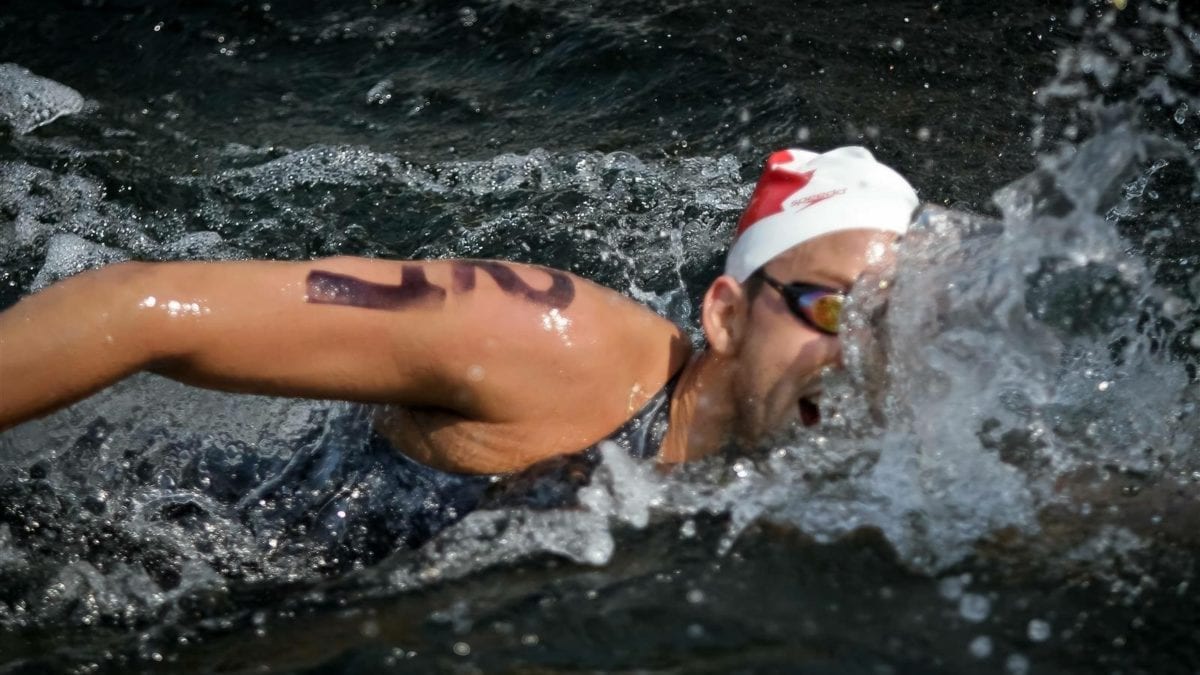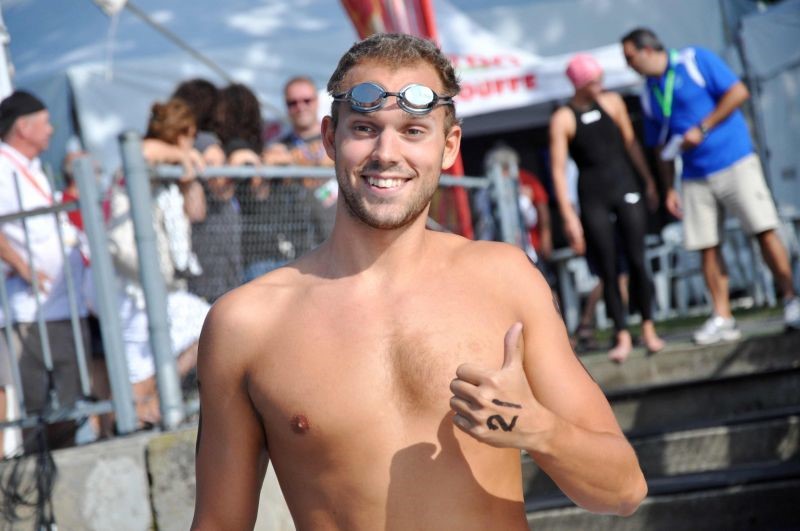Marathon swim champion explains how to master open water swimming
How Xavier Desharnais' experiences can help triathletes improve their swim splits
 Photo by:
Antoine Petrecca
Photo by:
Antoine Petrecca
It is hard to believe it was only a few short weeks ago that I stood on a beach in Guadeloupe, a bright-yellow inflatable buoy strapped to my waist. Seven of us huddled around Xavier Desharnais, soaking up his careful instructions.
The World Health Organization had not yet declared the outbreak of COVID-19 a pandemic. For me, the immediate existential threat was on the horizon, where waves broke on a shoal just beyond the bay, foaming white before rolling more gently towards the shore.
Swimming has never come naturally to me. I am a prairie girl and didn’t dip a toe in the ocean until my teens. My mother, raised on a farm, had a horror of drowning. Even watching over pre-schoolers at the wading pool, the tension in her voice conveyed that fear. She signed me and my siblings up for lessons, determined that her children would at least learn to float. Still, I was 10 before I got my beginner badge. It was by sheer force of will that I kept plowing through the Red Cross and then Royal Lifesaving Society programs in the early 1970s: my friends were going on Girl Guide canoe trips and playing water polo, and I did not want to be left out.
I did eventually become a competent and confident swimmer. But even with the less rough-and-tumble staggered starts at most triathlons these days, I still feel a twinge of nausea before every race. I have come to accept that the first 400 metres will be unnerving, until I find my groove.
So I welcomed the chance to attend a week-long tri camp in the French Antilles that was to focus on open-water swimming. Jean-Luc Méjane, the founder of Montreal-based Tripleaction triathlon training, had invited Desharnais — the first Canadian in the history of the mythic Traversée internationale Lac Saint-Jean to win the 32-kilometre crossing of the lake two years in a row, in 2014 and 2015.

Desharnais, 30, grew up in Sherbrooke, Que. He was a precocious swimmer from the start, following his big brother into competitive swimming at the age of seven. When he was 12 or 13, his club hired a new coach — a former marathon swimmer from Egypt, Mohamed Marouf, who saw in Desharnais a natural athlete who not only had that combination of speed and endurance, but the kind of singular determination it takes to be a long-distance swimmer.
By 14, Desharnais was already entering open water races, completing his first 34-km crossing of Lake Memphremagog at 18. For the next 10 years, Desharnais put in the miles that it takes to be among the world’s best open water swimmers: 80 to 100 km a week. He travelled the world, from Argentina to Serbia to Japan. He’s been stung by jellyfish, competed in Mexico with undiagnosed shingles that made each stroke agony, and been smacked down by every kind of wave. But to this day, nothing matches his first crossing of Lac St-Jean, 260 kilometres north of Quebec City.
Until it was conquered in 1955 by Quebecer Jacques Amyot, swimming across the choppy, glacier-fed lake was considered to be an impossible feat. These days, the race starts against the current, in the 13 C or 14 C waters of the Péribonka River, with the swimmers heading 500 m upstream before turning around.
“You jump in the water, and it feels like being pricked with knives, from head to toe. It’s hard to keep your head under water, it’s so cold,” says Desharnais. “You have to swim about an hour and a half in those conditions before you arrive at the lake. I remember thinking, I’ll never make it. It’s impossible. I was so cold, my lips were blue. I had to pee on my hands to warm them up.”
“Then when I reached the lake, the water was 60 or 65 degrees, which is really cold — but it was so much warmer, it felt like I had just swum into a hot bath.”
I could listen to Xavier’s tales for hours. It’s what makes him a much-sought-after motivational speaker. But the real joy comes with swimming alongside such a powerful and confident swimmer as he slows down to demonstrate how much less work it is to swim at someone’s hip. It is like learning kung fu at the hands of a master. This is what it means to feel one with the water.
I could share with you Desharnais’s tips for improving the triathlon leg of your swim: sight often, for starters. Get into the rhythm of it. Learn to lift your head just slightly and don’t breathe when you do it — head back down, turn to breathe. And practise, practise, practise. Find a buddy, find a lake, pick a tree on the horizon.
I could share with you his tips for swimming into shore: feel the wave as it lifts you forward and pick up your cadence. Relax the pace a little until the next wave. And always stretch, with every stroke, stretch as if you’re reaching for something just beyond your grasp.
But Desharnais’s main advice for triathletes is, just swim more often. He meets so many who debate the cost-benefit of spending more than the absolute minimum time in the water.
“In a triathlon, working so hard to cut one minute from an eight-hour race might seem ridiculous. But learning to swim and swim well is so fundamental,” he says. You may not immediately get faster, but you will become more efficient — and leave more energy for the next two legs.
He also thinks of it as a long-term investment.
“Swimming is going to give you back a lot more in your life than just finishing one triathlon,” he says. “At 65 or 70, when your knees are shot and you can no longer run, when you can’t take the chance of falling off your bike, there will still be swimming.”
“It both gives you energy and is calming. If you are mad, if you have a problem in your life, if you are stressed out, if you are sad about something, you can empty your mind completely. Or if you want, you can dwell on that problem and relax a bit, like the way your best ideas come to you when you’re sleeping. Swimming works the same way.”
Xavier Desharnais’s tips for triathletes:
- Swim more often. It’s better to do four shorter sessions in a week than one or two long ones. You have to practise constantly, until swimming feels like walking.
- Listen to your coach: It’s not easy to change your technique. Sometimes you need to go backwards in order to get further ahead. Accept advice.
- Consider hiring a private coach. For sure, when you have one coach for 10 or 15 swimmers, you can’t get the same level of specific feedback. In swimming, feedback is everything. You need someone to remind you often, ‘OK, do this like this, do this like that.’
- Learn to have fun in the water, not to fight it. Whether you are in the pool, in a lake or in the sea. There could be waves, you could choke, your stroke could be thrown off, but you need to keep reminding yourself, the water will always be more powerful than you, and all you can do is go with it. It’s a bit like a little kid playing with a big dog: they could be having a lot of fun, then the dog gets a bit rough, and it’s a bit scary. So — enjoy the water, but understand that it will always win. It’s the way of nature, of the planet and the way we interact with it. It’s fundamental to your way of being as a triathlete or a swimmer.
This story originally appeared in the May, 2020 issue of Triathlon Magazine Canada.
